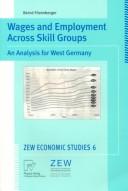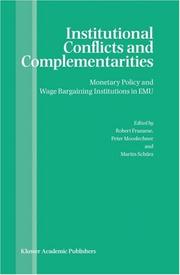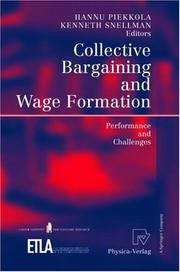| Listing 1 - 10 of 37 | << page >> |
Sort by
|
Book
Year: 1966 Publisher: New York: Wiley,
Abstract | Keywords | Export | Availability | Bookmark
 Loading...
Loading...Choose an application
- Reference Manager
- EndNote
- RefWorks (Direct export to RefWorks)
Book
ISBN: 9220323710 9789220323717 Year: 2020 Publisher: Genève 22 : International Labour Organisation (ILO),
Abstract | Keywords | Export | Availability | Bookmark
 Loading...
Loading...Choose an application
- Reference Manager
- EndNote
- RefWorks (Direct export to RefWorks)
This report analyses how migrant wages have evolved in 49 countries before the COVID-19 pandemic the difficulties faced by migrants in receiving the same pay as nationals. It examines gender discrimination and the difficulties migrants have in getting a job that corresponds to their level of education.
Migrant labor. --- Wage bargaining. --- E-books --- Migrant labor --- Wage bargaining

ISBN: 3790812358 9783790812350 Year: 1999 Publisher: Heidelberg: Physica-Verlag,
Abstract | Keywords | Export | Availability | Bookmark
 Loading...
Loading...Choose an application
- Reference Manager
- EndNote
- RefWorks (Direct export to RefWorks)
Labor market --- Unemployment --- Wage bargaining --- Wages
Book
Year: 2000 Publisher: Cambridge, Mass. National Bureau of Economic Research
Abstract | Keywords | Export | Availability | Bookmark
 Loading...
Loading...Choose an application
- Reference Manager
- EndNote
- RefWorks (Direct export to RefWorks)
Capitalist countries have historically had quite different labour market institutions and social policies. Do these differences produce sufficiently different economic outcomes to identify a single peak set of institutions? This paper shows that: 1. Labour market institutions have large effects on distribution, but modest hard-to-uncover effects on efficiency. 2. Institutional diversity is increasing among advanced countries, as measured by the percentage of workers covered by collective bargaining. 3. The case for the US having the institutions for peak economy status rests on its 1990s full employment experience, which arguably counterbalances its high level of economic inequality The historical pattern whereby some capitalist countries do better than others in some periods (ie Japan in the 1970s-1980s), then run into problems is more consonant with the view that capitalism permits national differences in institutions to persist than with the view that all economies must converge to a single institutional structure.
Wage bargaining. --- Capitalism. --- Income distribution. --- Labor market.
Book
ISBN: 9782296569553 Year: 2012 Publisher: Paris : Harmattan,
Abstract | Keywords | Export | Availability | Bookmark
 Loading...
Loading...Choose an application
- Reference Manager
- EndNote
- RefWorks (Direct export to RefWorks)
Women --- Wage bargaining --- Femmes --- Négociations salariales --- Employment --- Travail

ISBN: 1402075367 Year: 2004 Publisher: Dordrecht Kluwer Academic Publishers
Abstract | Keywords | Export | Availability | Bookmark
 Loading...
Loading...Choose an application
- Reference Manager
- EndNote
- RefWorks (Direct export to RefWorks)
Banks and banking, Central --- Institutional economics --- Labor unions --- Monetary policy --- Wage bargaining --- Economic and Monetary Union.

ISBN: 1280235136 9786610235131 3790815985 3790815586 Year: 2005 Publisher: Heidelberg ; New York, NY : Physica-Verlag,
Abstract | Keywords | Export | Availability | Bookmark
 Loading...
Loading...Choose an application
- Reference Manager
- EndNote
- RefWorks (Direct export to RefWorks)
This volume considers the development of the wage formation and wage bargaining institutions as a response to changes in the bargaining environment. These changes include a lower level of inflation and the growth in intraindustrial trade as firms have become more specialised. The response to these changes will depend on the current institutions and on the characteristics of the bargaining system. Generally there has been some move towards decentralisation; the question is what should be bargained centrally and which issues should be transferred to lower levels. Some of the contributions pay special attention to Nordic regimes using survey results gathered from the Finnish labour market partners.
Wage bargaining --- Collective bargaining --- Bargaining --- Labor negotiations --- Industrial relations --- Negotiation in business --- Labor economics. --- Macroeconomics. --- Labor Economics. --- Macroeconomics/Monetary Economics//Financial Economics. --- Economics
Book
ISBN: 149839258X Year: 2014 Publisher: Washington, D.C. : International Monetary Fund,
Abstract | Keywords | Export | Availability | Bookmark
 Loading...
Loading...Choose an application
- Reference Manager
- EndNote
- RefWorks (Direct export to RefWorks)
All end-June performance criteria and indicative targets under the ECF arrangement were met, and all structural benchmarks were completed, albeit with minor delays. However, there was a nonobservance of the continuous performance criterion on the ceiling on new nonconcessional external debt in July with the issuance of the US$750 million Eurobond (exceeding the US$500 million program ceiling).
Dissertation
ISBN: 9187268299 Year: 1995 Publisher: Uppsala Uppsala University. Department of economics
Abstract | Keywords | Export | Availability | Bookmark
 Loading...
Loading...Choose an application
- Reference Manager
- EndNote
- RefWorks (Direct export to RefWorks)
331.2 --- 331.5 --- Job hunting --- -Wage bargaining --- -Collective bargaining --- Hunting, Job --- Job searching --- Employment agencies --- Vocational guidance --- Loon. Salaris. Vergoeding --(algemeen) --- Arbeidsmarkt. Werkgelegenheid --(algemeen) --- Mathematical models --- Theses --- Wage bargaining --- Mathematical models. --- -Loon. Salaris. Vergoeding --(algemeen) --- 331.5 Arbeidsmarkt. Werkgelegenheid --(algemeen) --- 331.2 Loon. Salaris. Vergoeding --(algemeen) --- -Hunting, Job --- Collective bargaining
Book
ISBN: 1462378323 1455223220 1281990167 9786613794598 1455290718 Year: 1993 Publisher: Washington, D.C. : International Monetary Fund,
Abstract | Keywords | Export | Availability | Bookmark
 Loading...
Loading...Choose an application
- Reference Manager
- EndNote
- RefWorks (Direct export to RefWorks)
The main focus of the “wage bargaining” literature has been on the factors promoting real wage flexibility at the macro level. This paper, in contrast, examines the microeconomic issues of wage bargaining. More specifically, this paper appraises the following questions: (a) what are the conditions under which a firm prefers decentralized to centralized bargaining?, (b) what are the characteristic features of firms which prefer decentralized to centralized bargaining?, and (c) has the proportion of firms which prefer decentralized bargaining increased over time? These questions are examined in an efficiency wage model with insider-outsider features. This paper provides useful theoretical insights for understanding the issues involved in shifting from centralized to decentralized wage bargaining.
Labor --- Macroeconomics --- Wages, Compensation, and Labor Costs: General --- Wages, Compensation, and Labor Costs: Public Policy --- Labor Economics: General --- Labour --- income economics --- Wages --- Wage bargaining --- Real wages --- Wage adjustments --- Labor economics --- Sweden --- Income economics
| Listing 1 - 10 of 37 | << page >> |
Sort by
|

 Search
Search Feedback
Feedback About UniCat
About UniCat  Help
Help News
News